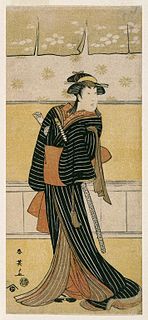 W
WThe Katsukawa school was a school of Japanese ukiyo-e art, founded by Miyagawa Shunsui. It specialized in paintings (nikuhitsu-ga) and prints of kabuki actors (yakusha-e), sumo wrestlers, and beautiful women (bijin-ga).
 W
WKatsushika Hokusai, known simply as Hokusai, was a Japanese artist, ukiyo-e painter and printmaker of the Edo period. Hokusai is best known for the woodblock print series Thirty-Six Views of Mount Fuji which includes the internationally iconic print The Great Wave off Kanagawa.
 W
WKatsukawa Shun'ei was a Japanese ukiyo-e artist.
 W
WKatsukawa Shunchō was a Japanese designer of ukiyo-e style Japanese woodblock prints, who was active from about 1783 to about 1795.
 W
WKatsukawa Shunkō I was a Japanese artist who designed ukiyo-e-style woodblock prints and paintings in Edo. He was a student of Katsukawa Shunshō, and is generally credited with designing the first large-head actor portraits (ōkubi-e). As his teacher did, Shunkō used a jar-shaped seal and was known as kotsubo. At 45, the right-handed Shunkō became partially paralyzed and ceased designing prints, although he continued producing paintings with his left hand.
 W
WKatsukawa Shunsen , who is also known as Shunkō II, was a designer of books and ukiyo-e style Japanese woodblock prints. He was born in 1762 and designed prints from about 1805 to about 1821. He initially studied with the Rimpa school artist Tsutsumi Tōrin III. In 1806 or 1807, Shunsen became a student of Katsukawa Shun'ei, and changed his name from “Kojimachi Shunsen” to “Katsukawa Shunsen”. In 1820 he succeeded Katsukawa Shunkō I, becoming Katsukawa Shunkō II. In the late 1820s, he ceased producing woodblock prints and devoted himself to painting ceramics. He died about 1830.
 W
WShunshō Katsukawa was a Japanese painter and printmaker in the ukiyo-e style, and the leading artist of the Katsukawa school. Shunshō studied under Miyagawa Shunsui, son and student of Miyagawa Chōshun, both equally famous and talented ukiyo-e artists. Shunshō is most well known for introducing a new form of yakusha-e, prints depicting Kabuki actors. However, his bijin-ga paintings, while less famous, are said by some scholars to be "the best in the second half of the [18th] century".